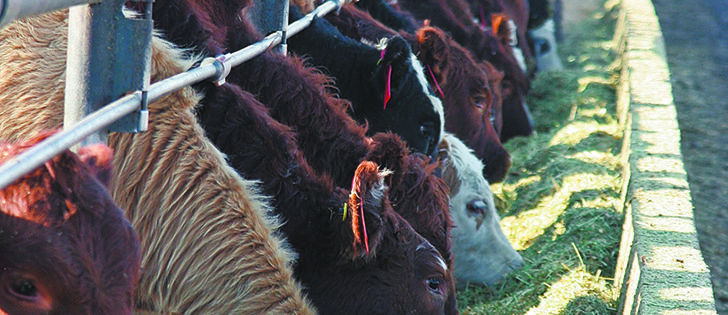Some question Tyson Foods’ health concerns
Peter Anderson deplores the loss of Zilmax in the North American feedlot industry.
The Colorado-based researcher and consultant for one of the top livestock supplement suppliers in the United States said he can’t predict whether Merck will return the growth-promoting beta agonist to the market.
If it does, good. If it doesn’t, less beef will be produced and feedlot efficiency will suffer.
“It’s a remarkably efficacious product,” said the director of re-search for Midwest PMS.
“It delivers excellent value for cattle producers and it helps us to remain competitive among other protein segments and other beef producing countries around the world.”
Read Also

Quebec pork company calls for transparency around gene-edited pigs
Quebec-based pork company duBreton is calling for transparency around meats from gene-edited pigs on concerns that a lack of mandatory labelling will confuse consumers, and dilute certification claims. The organic sector is also calling for labelling rules.
Merck, the makers of Zilmax, removed the product from the market in August after Tyson Foods Inc. said it would stop buying Zilmax-fed cattle in September.
Tyson cited concerns that the product caused lameness in fed cattle, although no definitive proof has been supplied.
Zilmax is one of two beta agonists available to Canadian cattle producers. Its active ingredient is zilpaterol. The other product is Opti-flexx, manufactured by Elanco, with the active ingredient being ractopamine.
Anderson recently told a Alberta Cattle Feeders Association meeting that he suspects Tyson made its decision in response to consumer pressure.
“It concerns me if ever they take a product off the market or quit using one that’s FDA (U.S. Food and Drug Administration) approved, safe and effective and helps our competitive position, for some other reason that they’ve got.”
He said beta agonists and implants are useful tools to increase weight gain and cattle feeding operation efficiency.
“We’ve lost one of our key tools and if it’s gone for good, and it might be, we’ve got to find other ways” to put additional weight on cattle, Anderson said.
Merck claims Zilmax can put an additional 33 pounds on feeder cattle, but Anderson said even better results than that are possible.
Sterling Fox, director of procurement for the JBS slaughter plant in Brooks, Alta., said his company, the largest livestock processor in the world, does not have an official position on Zilmax.
He said the point is moot because Merck withdrew the product, citing plans for further study.
However, the product is known to put extra weight on animals, and with cattle numbers at nearly all-time lows, extra pounds will be missed.
“It will just be more cattle through the facility and less pounds, but Merck’s got their job to do, I guess,” he said.
“They have their reasons for doing what they’re doing, so I guess we’ll watch and see how things work out.”
Howard Bekkering, cattle feeder council chair for Alberta Beef Producers, said he’s never seen lameness in cattle fed Zilmax, and there is a noticeable benefit to cattle feeders when it is used.
Cattle feeder Chuck MacLean agreed.
“As a producer, it’s worth $25 to us in a feedlot. If nobody uses it, I guess then everybody is on an equal playing field,” he said.
“If the product is there and my competitor is using it, we tend to use it because you can’t give a guy a $25 advantage and expect to stay in business, and the margins in the feedlot business have been really tight.”
Beta agonists are often used in conjunction with hormone implants, a practice Anderson recommends to improve feedlot efficiency and return.
Implants, released through a pellet inserted in an animal’s ear, work throughout a longer portion of the feeding period. Beta agonists are generally provided in the last 20 to 40 days on feed, acting to stimulate muscle growth and reduce accumulation of fat.
Implants can increase feed intake by up to six percent within 24 hours, said Anderson.
“That’s a big deal, and the reason that’s a big deal is because that’s all over maintenance,” he said.
“All of that goes to growth.”
He said each additional pound of feed intake creates an additional quarter pound of gain because the first 12 lb. of feed consumption goes to maintenance. The rest is muscle gain.
“That’s why it improves efficiency so much to get that extra intake. What they gain is much more efficient when they’ve got implants stimulating that growth because there’s more muscle … and muscle contains fewer calories than fat so it’s more efficient to put on. There’s nothing we do that’s got the same ROI (return on investment) as an implant program.”
- Full name is beta adrenergic agonists; beta referring to a particular receptor, adrenergic meaning it resembles adrenaline and agonist meaning the opposite of antagonist.
- They have been commercially available since 2004.
- Provided the last 20 to 40 days on feed to redirect nutrients and promote muscle growth.
- Two brands are available in Canada: Zilmax (active ingredient zilpaterol) and Optiflexx (active ingredient ractopamine).
- Commercially available for many years to enhance hormones produced naturally by the animal. They can replace some hormones lost by steers via castration.
- Administered through a pellet inserted under the skin in the ear to encourage muscle growth and discourage fat deposition.
- Can affect carcass quality.
- Antimicrobials that improve nutrient availability through feed.
- They act upon microbes in the rumen to prevent diseases and reduce bloat and acidosis.
- Types common to cattle feed not used in human medicine.


















